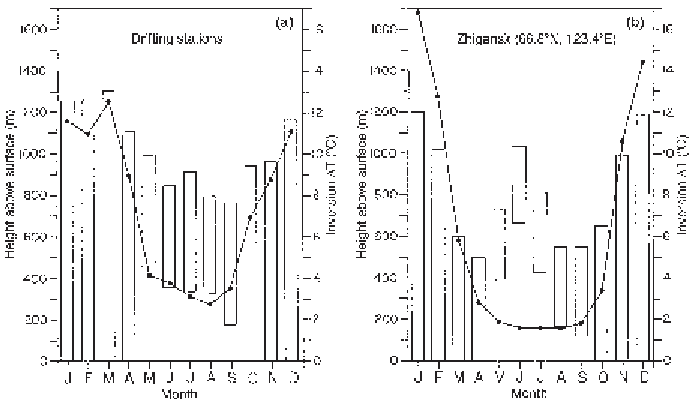Geoscience Reference
In-Depth Information
Figure 5.14.
Monthly median inversion top (top of bars), base (bottom of bars) and
temperature difference (solid lines) from (a) drifting station data from the central Arctic
Ocean; and (b) station Zhigansk over the Siberian tundra (from Serreze et al.,
1992b
,
by permission of AMS).
the top of the inversion layer (Bridgman et al.
1989
). Photochemical destruction of
boundary-layer ozone at Arctic sunrise (Barrie et al.,
1988
; Oltmans et al.,
1989
)
appears to involve a process in which ozone-depleted air within the inversion layer
is occasionally replaced by above-inversion, ozone-rich air, via mixing processes.
Wexler (
1936
) was the first to propose maintenance of the winter Arctic tempera-
ture inversion in terms of approximate longwave radiative equilibrium. He consid-
ered an ideal sounding consisting of a surface inversion of infinitesimal thickness
below an isothermal layer extending up to a nearly adiabatic temperature layer.
Wexler hypothesized that the nearly blackbody emission of the snow surface was
in radiative equilibrium with the partial emission of the isothermal layer. Put differ-
ently, because the atmosphere has a lower emissivity than the surface, radiative equi-
librium requires that the surface be radiating at a lower physical temperature than
the air in the isothermal layer. A shortcoming of this idea is that the system is not
closed - the isothermal layer radiates longwave energy upward into space. Hence,
its temperature will drop and the inversion will weaken. Also, over the Arctic Ocean
in winter, the longwave radiation emitted from the surface is primarily balanced by
both the downward longwave radiation and a conductive heat flux through the ice.
His concept was important, however, in stating that the surface and temperature
maximum layer are strongly coupled through radiative processes.
Overland and Guest (
1991
) examined the problem of the winter temperature
inversion over the Arctic Ocean using a one dimensional atmospheric radiation
model. A steady thermodynamic model for the skin temperature was employed bal-
ancing the surface longwave radiation deficit with a conductive heat flux through

